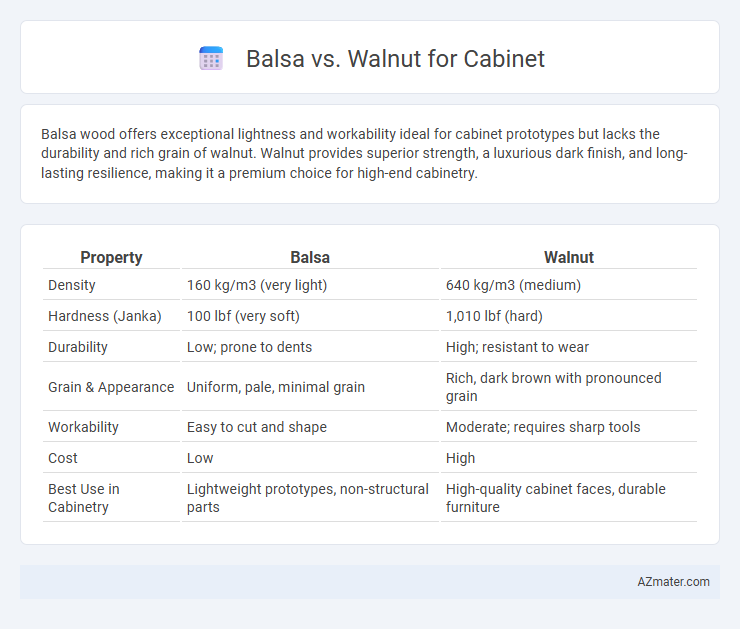Balsa wood offers exceptional lightness and workability ideal for cabinet prototypes but lacks the durability and rich grain of walnut. Walnut provides superior strength, a luxurious dark finish, and long-lasting resilience, making it a premium choice for high-end cabinetry.
Table of Comparison
| Property | Balsa | Walnut |
|---|---|---|
| Density | 160 kg/m3 (very light) | 640 kg/m3 (medium) |
| Hardness (Janka) | 100 lbf (very soft) | 1,010 lbf (hard) |
| Durability | Low; prone to dents | High; resistant to wear |
| Grain & Appearance | Uniform, pale, minimal grain | Rich, dark brown with pronounced grain |
| Workability | Easy to cut and shape | Moderate; requires sharp tools |
| Cost | Low | High |
| Best Use in Cabinetry | Lightweight prototypes, non-structural parts | High-quality cabinet faces, durable furniture |
Introduction: Balsa vs Walnut for Cabinet Making
Balsa and walnut differ significantly in cabinet making due to their physical properties and durability. Walnut offers superior strength, rich color, and a fine grain pattern ideal for high-end cabinetry, while balsa is exceptionally lightweight and soft, making it less suitable for structural applications. Selecting walnut ensures long-lasting, elegant cabinets, whereas balsa is mainly reserved for prototype models or decorative elements where weight reduction is essential.
Material Overview: Properties of Balsa and Walnut
Balsa wood is extremely lightweight with a low density of about 160 kg/m3, making it ideal for applications where weight reduction is critical, although it lacks durability and hardness. Walnut is a dense hardwood, averaging 640 kg/m3 in density, known for its excellent strength, rich color, and fine grain, providing superior durability and aesthetic appeal in cabinetry. While balsa is easy to cut and shape due to its softness, walnut offers better resistance to wear and impact, making it a preferred choice for high-end, long-lasting cabinets.
Strength and Durability Comparison
Walnut wood is significantly stronger and more durable than balsa, making it ideal for cabinetry that requires long-term resilience and resistance to scratches and dents. Balsa is exceptionally lightweight but lacks the hardness needed to withstand heavy use and physical impacts over time. For cabinet construction prioritizing strength and longevity, walnut provides superior structural integrity and wear resistance.
Weight Differences and Their Impact
Balsa wood is significantly lighter than walnut, with balsa weighing around 160 kg/m3 compared to walnut's denser 640 kg/m3, making balsa ideal for applications requiring minimal weight. The lighter weight of balsa reduces cabinet overall load, easing installation and enhancing portability, but it compromises durability and strength. Walnut's heavier weight contributes to superior structural integrity and longevity in cabinetry, supporting heavy hardware and frequent use without warping or damage.
Visual Appeal: Grain and Color Variations
Balsa wood displays a light, pale color with a very fine, almost uniform grain that provides a smooth and minimalist visual appeal ideal for modern or Scandinavian-style cabinets. Walnut offers rich, dark brown tones with varied grain patterns, including straight, wavy, and curly, delivering a warm, luxurious look often favored in traditional and high-end cabinetry. The contrast between balsa's subtle, soft appearance and walnut's bold, complex textures allows for diverse aesthetic choices depending on desired style and visual impact.
Workability and Ease of Machining
Balsa wood, known for its extremely lightweight and soft texture, offers exceptional workability and ease of machining, making it ideal for intricate detailing in cabinets. Walnut, a denser hardwood with a fine grain, provides a smooth machining experience but requires sharper tools and more effort compared to balsa. For cabinet construction, balsa allows faster shaping and sanding, while walnut delivers superior durability with moderate machining complexity.
Cost Analysis: Balsa vs Walnut
Balsa wood is significantly more affordable than walnut, often costing a fraction of the price due to its lightweight and fast-growing nature, making it ideal for budget-conscious cabinet projects. Walnut, known for its rich color and durability, commands a higher price point that reflects its premium quality and longevity in cabinetry. When comparing cost analysis, balsa offers economical benefits for decorative or lightweight applications, whereas walnut provides a valuable investment for high-end, durable cabinet construction.
Environmental Impact and Sustainability
Walnut cabinets are prized for their durability and rich aesthetic but have a higher environmental impact due to slower growth rates, leading to increased deforestation concerns. Balsa wood, known for its rapid growth and renewable properties, offers a more sustainable option with lower carbon emissions and reduced habitat disruption. Choosing balsa over walnut can significantly decrease the ecological footprint of cabinetry projects while still providing adequate strength for certain applications.
Best Use Cases for Each Wood Type
Balsa wood, prized for its lightweight and soft texture, is best suited for cabinet interiors, model-making, and decorative panels where minimal weight and ease of shaping are critical. Walnut, known for its rich color, durability, and hardness, excels in high-end cabinetry, visible cabinet faces, and furniture pieces requiring longevity and a sophisticated appearance. Choosing walnut ensures resistance to wear and a polished finish, while balsa offers affordability and ease for non-structural, creative applications.
Final Recommendations for Cabinet Selection
Walnut offers superior durability, rich color, and natural resistance to wear, making it an ideal choice for high-quality, long-lasting cabinets. Balsa, while lightweight and easy to work with, lacks the strength and density required for heavy-use cabinetry, limiting its suitability to decorative or lightweight applications. For cabinets that demand both aesthetic appeal and functional longevity, walnut is the recommended material.

Infographic: Balsa vs Walnut for Cabinet
 azmater.com
azmater.com